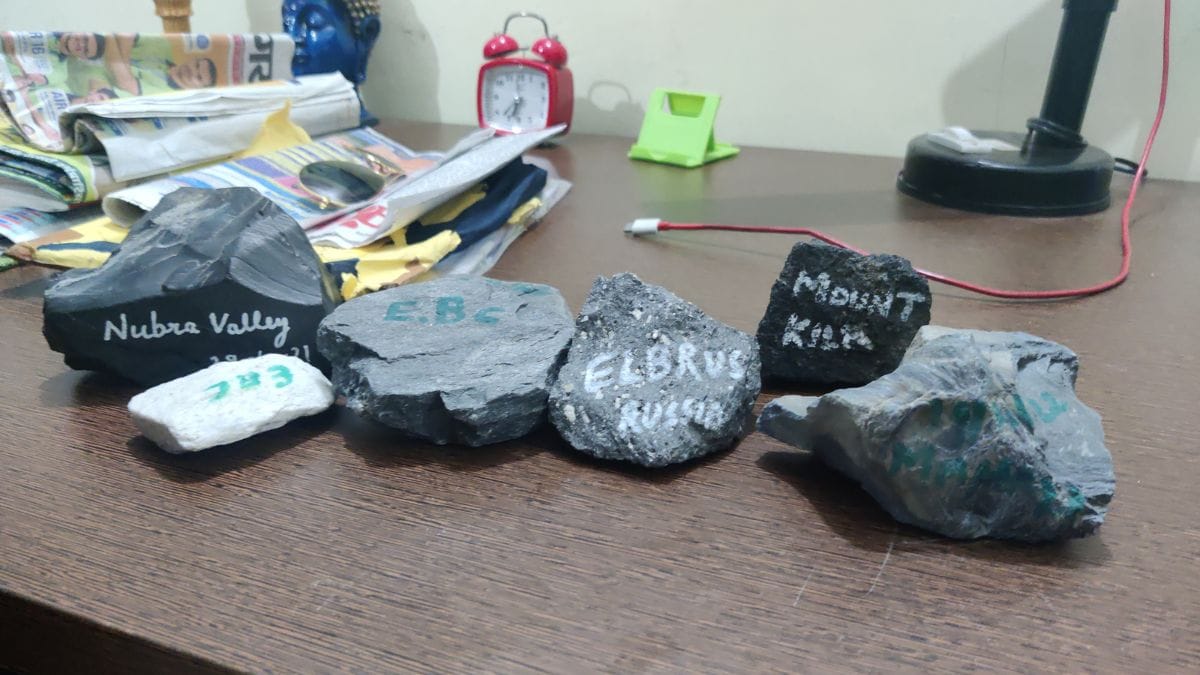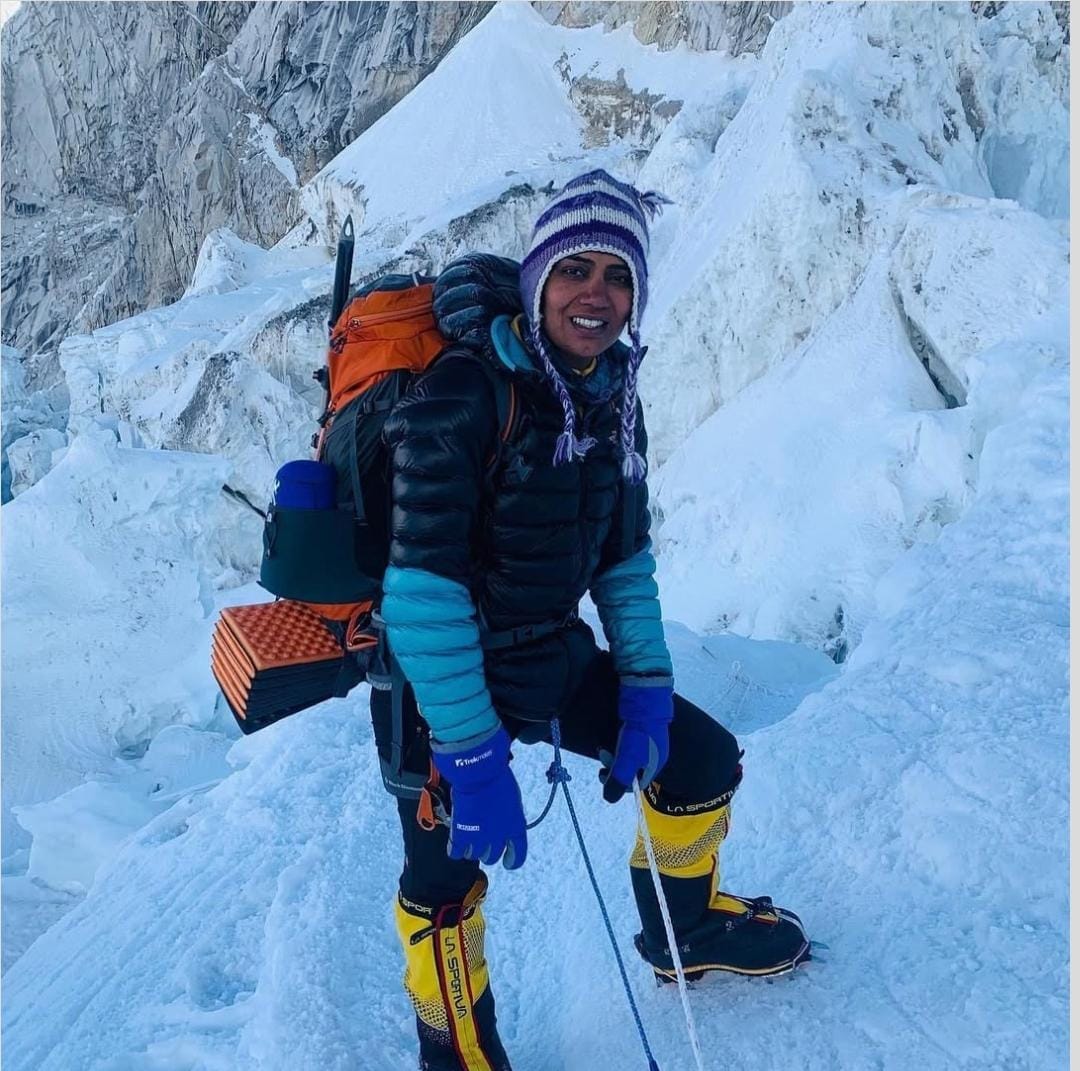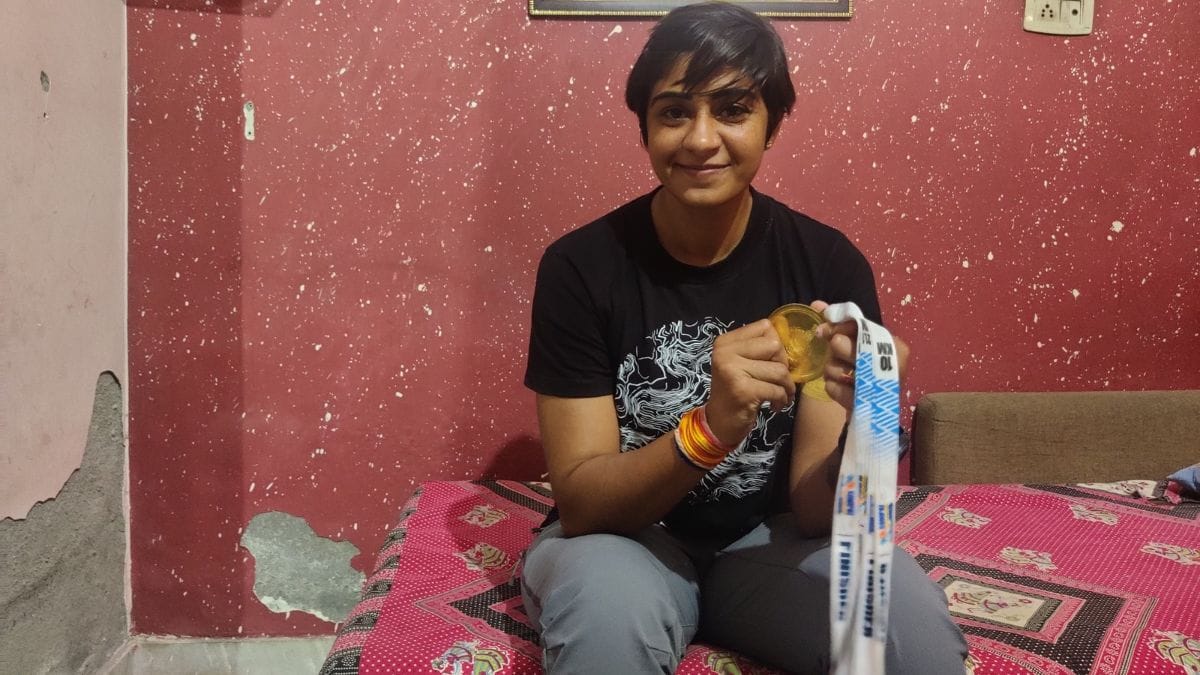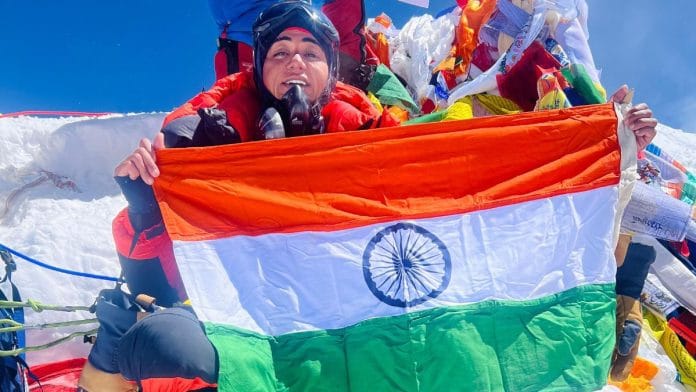In 2023, Reena Bhati was just 50 meters from the summit of Mount Everest — and from fulfilling her dream. But her will, no matter how strong, couldn’t hold against the forces beyond her control. Her sherpa would leave her midway. The peak slipped away, and her dream pushed a year further.
In 2024, she returned — this time wearing a vibrant Haryanvi ghagra-choli. And when she finally stood atop the world, she danced in joy and cried— a cascade of emotions poured out as she unfurled the Indian flag.
“In that moment in 2023, I didn’t know how I’d face my family. I had come with sponsors, crowdfunded money, so many hopes. But I had to turn back—it felt like Everest didn’t want me. My heart stayed broken for a year. In 2024, Everest welcomed me with open arms,” said Bhati from Hisar, Haryana.
Despite her achievements, Bhati faces major challenges due to the lack of stable employment and financial support from the government for climbers. This hinders her ability to focus on her sport, and she worries it sends a discouraging message to other aspiring female athletes.
Mountaineering isn’t new to Haryana — Santosh Yadav, Mamta Sodha, and Anita Kundu are inspiring stories. It was Kundu’s grit that pushed the state to draft a mountaineering policy. But today, that policy feels outdated, falling short of meeting the aspirations of young mountaineers who expect greater government support. Bhati, 35, known as ‘Himputri,’ who scaled Everest and Lhotse within 20 hours, is demanding more. Despite climbing over 20 peaks, she’s still fighting for recognition, a Grade A job, and support equal to what sports stars like Vinesh Phogat once received. She’s taken her case to the chief minister and submitted policy reforms herself.
While many mountaineers from Haryana such as Narender Kumar, Manoj Kumar, Meenu Kaliraman, and Amit Kumar have supported Bhati’s call, not everyone agrees with her demands. A new debate is emerging in Haryana — do mountaineers deserve the same support as athletes in other fields?
Bhati, along with fellow mountaineers Narender Kumar, Manoj Kumar, Meenu Kaliraman, and Amit Kumar,
met Haryana Chief Minister Nayab Singh Saini and Sports Minister Gaurav Gautam in June and again in November 2024
“Haryana’s daughters in wrestling have received so much support from the government, and other sports too. We’re just asking for the same rights. Our sport is so risky—we spend so much money from our own pockets to compete, and in return, the government gives us just Rs five lakh, and I haven’t even received that yet,” said Bhati.
After her 2023 setback, Reena Bhati actively lobbied for state support—writing to government departments, tagging officials on social media, and giving interviews.
Bhati, along with fellow mountaineers Narender Kumar, Manoj Kumar, Meenu Kaliraman, and Amit Kumar, met Haryana Chief Minister Nayab Singh Saini and Sports Minister Gaurav Gautam in June and again in November 2024. Bhati also sent a letter to the CM about a month ago. They highlighted their achievements and appealed for stronger institutional support, stressing the need for structured funding, recognition, and long-term welfare measures. Now, they wait patiently.

Also read: The secret sex life of India’s college students. How they battle campus CCTVs & curfews
Dreams, disappointments
In 2024, when reached the top of Mt. Everest. Her successful summit wasn’t just a personal milestone. It stood for every girl back home who was told “she couldn’t.”
Today, her strength wavers. When she looks at her father — a tractor mechanic — his tired face tells a story of lifelong struggle. And every time their eyes meet, the tears come, betraying the resolve she tries so hard to keep.
Her family’s financial situation has worsened due to her sacrifices for the sport. Whenever she goes to practice, she’s not even recognised as an athlete. They demand to see her ID card, but she can’t provide one, as the government hasn’t officially recognised her. She was even kicked off the practice ground for lacking an ID card. When she identified herself as an athlete and even showed them Google results, they still refused to acknowledge her.
“Reena, you’re strong. Don’t cry,”—Bhati repeats these words in her mind. But her heart, heavy with defeat and betrayal, won’t listen. Her disappointment is visible in her Facebook post: “I’ve achieved nothing, no matter how many records I’ve made.”
Bhati wants to buy her father a new pair of shoes, gift her mother a life of peace, and carve out a name for herself that the nation will never forget.
“I’ve been mountaineering for five years, and in 2024, I summited both Mt. Everest and Mt. Lhotse within just 20 hours—bringing pride to India. But even today, I haven’t been able to repay the loan I took. I still haven’t been able to give my family the better life they deserve,” she said.
Bhati’s story is not an isolated one. Many young mountaineers in India face similar struggles despite their achievements and share the same demand for recognition.
At just 16, Shivangi Pathak became one of India’s youngest mountaineers to scale Mount Everest. Since then, she’s gone on to summit Africa’s Mount Kilimanjaro, Europe’s Mount Elbrus, and most recently, on 26 January 2025, Australia’s highest peak—Mount Kosciuszko. Closer to home, she conquered Mount Stok Kangri in Ladakh and Kedarkantha in Uttarakhand.
In 2019, she raised the issue of proper recognition for real mountaineers during a meeting with Prime Minister Narendra Modi who felicitated her with the PM Bal Shakti Puraskar. “He said, ‘I will definitely do something about it. If you go ahead honestly, you will get opportunities,’” she recalled.
I’ve been mountaineering for five years, and in 2024, I summited both Mt. Everest and Mt. Lhotse within just 20 hours—bringing pride to India. But even today, I haven’t been able to repay the loan I took. I still haven’t been able to give my family the better life they deserve
Reena Bhati, Haryana mountaineer
She said mountaineers still lack the recognition they deserve.
“Even punching and hitting each other has become an Olympic sport—wrestling, boxing, kabaddi—and they earn money for it,” said Pathak. “But when mountaineers put in equal or greater effort, we’re ignored. Their injuries heal; for us, it’s Aar ya Paar—either you summit or you risk your life.”
Also read: Brahmins & Buddhists are fighting over Nehru, Khilji, and Bodh Gaya Temple Act
Athlete vs mountaineer
The debate among mountaineers of Haryana isn’t homogenous and some don’t approve of demands of government support. Instead, they are for taking a nuanced view of their achievements.
“Not everyone can get a government job—that’s just not possible. The question is: did someone discover a new route? What was the quality of the climb? If there’s a genuine achievement, there’s no harm in giving recognition,” said Anita Kundu, Haryana’s celebrated mountaineer who is also an inspector in Hisar. Kundu was appointed OSD (Officer on Special Duty) in the CM’s office in 2023.
Anita Kundu is the first Indian woman to summit Mt. Everest from both the Nepal and China (2017) sides. In addition to Everest, she has successfully conquered Mount Makalu and Mount Manaslu, two of the world’s most formidable peaks.
Kundu, 35, grew up in a small village in Hisar. Life turned harsh early—she lost her father at just 12. While other kids played, she was out selling milk, stitching clothes, and doing household chores—not just to fund her brother’s education, but to keep her own dreams alive. At 15, when relatives pressured her to marry, she stood ground and walked away from a path laid out for her by others. She built her own instead.
After completing her studies, she got a position in the police force as a constable through her own efforts.
It takes athletes 20 years of hard work to reach the Olympics. In mountaineering, you do a 1–2 month course, learn, and go. So asking for the same support and respect as Olympic athletes would be foolish
Anita Kundu, Haryana mountaineer
It was Kundu’s relentless efforts that led Haryana to create a mountaineering policy in the first place. She received the Tenzing Norgay National Adventure Award from the President of India, one of the country’s highest honors for mountaineering.
Her views on government support for mountaineers differ strictly from many in the climbing community.
“It takes athletes 20 years of hard work to reach the Olympics. In mountaineering, you do a 1–2 month course, learn, and go. So asking for the same support and respect as Olympic athletes would be foolish,” she said.
Kundu, a three-time Everest summiteer, was promoted from constable to sub-inspector during the Bhupinder Singh Hooda government’s second tenure.
“I’ve been working for 20 years—don’t I deserve even a single promotion after all this time?” she said. “And yet people say I only got this job because I’m a mountaineer.”
She said if a sportsperson gets a government job, it should be in the sports department so they can inspire the next generation and produce more talents like themselves.
She expressed her frustration with the current trend of mountaineering that involves crowdfunding, taking out bank loans, and climbing commercial peaks with Sherpas, only to return home expecting a government job. She said scaling a popular, well-known mountain doesn’t necessarily bring glory to the nation.

“Some climbers from Haryana have even faked ascents and demanded jobs. When asked for proof—certificates, summit photos, coordinates—they have nothing to show. That’s what’s ruining the name of mountaineering.”
In 2016, Narender Singh Yadav gained attention as the youngest Indian to summit Everest, but his achievement was later exposed as alleged fraud. Allegations surfaced after discrepancies in his summit photo, including shadows in the wrong direction and a missing tube on his oxygen mask.
Climbing in India is much more challenging than in other countries in the absence of supporting infrastructure.
“In India, you have to do everything on your own. You only get Sherpas to the base camp, and even high-altitude Sherpas only go as far as a certain level, often at the same cost,” said Anusha Subramanian, an independent journalist and mountaineer.
In Indian expeditions, climbers carry their own gear, do a load check by transporting luggage to higher camps, and return to base camp to rest. This process is repeated until reaching the summit camp, where, if the weather permits, the final push to the summit is made.
“Unlike Nepal, where paid services can handle much of the logistics, in India, it’s all about self-reliance,” said Subramanian.
Bhati claims to have successfully climbed eight notable peaks in India, including Mount Nun (7,135 meters) in Ladakh, Friendship Peak (5,289 meters) in Himachal Pradesh, and Ut Kangri (6,070 meters) in Ladakh, which she ascended during both a winter expedition and an attempted climb.
Subramanian said that climbing should not be viewed simply as a shortcut to awards. “Anyone can claim to have climbed. But the real issue is that there’s no one on the panel assessing the hardships, the quality of the clients, or the true caliber of the climbs.”

Also read: How Hyderabad became a city of studios. Baahubali to Jawan & Fauji came calling
The policy shortfall
The Haryana government formalised a policy in 2021 for mountaineers from the state who summit any of the world’s top 10 peaks, including Mount Everest. According to the Policy to Encourage Mountaineers of Haryana, climbers will receive a cash reward of Rs 5 lakh and a Grade C Sports Gradation Certificate, making them eligible for government jobs under the sports quota.
The Gujarat government, through its Youth and Culture Department, offers financial support to mountaineers: Rs15 lakh for summiting Everest, Rs 10 lakh for 8,000-meter peaks, and around Rs 1 lakh for 6,000-meter climbs. The scheme applies to individuals between 18 and 45 years of age as it’s specifically targeted at the youth.
The Uttar Pradesh government too provides financial incentives for mountaineers: Rs 15 lakh for summiting 8,000-meter peaks and Rs 5 lakh for 7,000-meter climbs. But there’s no certification, no job benefit. It’s just a one-time reward.
These policies offer immediate benefits like cash rewards and job eligibility, but they may overlook the complexities of mountaineering.
“When making policies, consider how many difficult peaks you’ve climbed in India. There should be a system to assess a climber’s true abilities. Only then should a climb like Everest be truly acknowledged,” said Vijay Singh, the president of the Indian Mountaineering Foundation.
A mountaineer from UP who requested anonymity, shared his experience of attempting a winter ascent of an unclimbed peak in Ladakh—a pure exploration effort that took four years and three failed attempts due to avalanches and unknown routes.
“No one had done it before. We didn’t even know the way. First time, wrong route. Second and third, avalanches. We finally summited in the fourth attempt.” But such risky exploration is rarely supported. “Who pays for it?” he asked. “The private sector doesn’t care. The government only rewards success—no one funds attempts or exploration.”
Despite India being home to hundreds of the Himalayan range, Bhati said, “India is still not among the top 10 or 20 mountaineering nations.”
Bhati, however, is determined to keep fighting. People often start by appreciating her, but then dismiss her efforts, questioning why she pursued mountaineering, spent so much money, and troubled her parents when she ended up in a private job anyway.
“I’m part of the government’s role model programmes, my story is told to inspire children—but the reality is something else entirely. What should I even tell these kids now? Not to climb mountains? That I made a mistake by doing it myself?”
Editor’s Note: Brigadier Ashok Abbey (retd) withdrew his comments and his mention in the story
(Edited by Anurag Chaubey)






